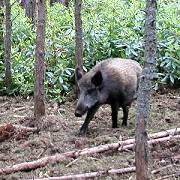Summary
Species being researched
As we do not have the resources to work on all species simultaneously and some have good advisory material based on previous research, current research concentrates on a few species:
Research aims
- To provide evidence based expertise, information, advice and pragmatic guidance on the impacts and management of woodland based invasive vertebrate species.
- To investigate and improve on efficacy of current management techniques and delivery options.
- To investigate novel control methods especially if appropriate for several species.
- To contribute to public debate on non-native and invasive species and the consequences of action/inaction.
- To contribute to national Risk Assessments for woodland dwelling invasive species under the Defra NNS scheme.
Selecting species for research
Invasive or non-native woodland vertebrates may be widespread or currently localised but have potential to increase and spread along tree lined landscape corridors in response to climate change accompanied by unacceptable impacts on trees and woodland biodiversity. The risk posed by both non-native and invasive species is evaluated from national and international information on:
- Recent evidence of, or potential for spread
- Biodiversity impacts
- Damage to growing trees, either indirectly or directly
- Public, health and safety or disease issues.
Resources on other species
- Feral goat
- Native deer
- Rabbits
- Sika deer
- Voles
Researching management of feral wild boar

Although wild boar became extinct in Britain for the second time some 300 years ago, they are again living free in parts of England and Wales and have recently been reported in Scotland. All wild boar living free in Britain today result from animals that were imported and kept under licence in zoos and wildlife collections or on wild boar farms.
Video footage of Wild Boar, encountered whilst surveying to estimate population density of Wild Boar, in Alto Merse, Siena. The first clip is of a sounder of two adults and five piglets, the second is a single adult. Thermal imaging makes it much easier to detect animals which are shy or largely nocturnal.
The survey was part of a project to develop monitoring methods for wild boar for future application on British wild boar populations. Carried out in collaboration with ISPRA (Istituto Superiore per la Protezione e la Ricerca Ambientale) and FERA (Food and Environment Research Agency).
Video captured using a FLIR® ATS Thermal imaging weapon sight.
Current management policy
Primary responsibility for feral wild boar management lies with local communities and individual landowners.
Population
In England, feral wild boar are present on the public forest estate in Kent and Sussex (Forestry Commission (FC) South East England) and in Gloucestershire and Herefordshire (FC Forest of Dean). There are suggestions that boar may be present on the public forest estate in Devon (FC Peninsula) and Dorset (FC New Forest). There are also small localised populations in Wales and Scotland.
Internationally the wild boar is recognised as one of the most invasive vertebrates and their numbers have been increasing in many European countries. Typically, feral populations appear to remain low for many years before rapidly expanding. In the UK feral wild boar populations may still be in this initial phase.
Wild Boar and Deer Census, Forest of Dean 2014(PDF-957K)
Research by Forest Research
- Collating information on boar distribution on the forest estate and elsewhere in England, Wales and Scotland
- Developing methods of estimating abundance of wild boar
- Improving boar management capability
- Investigating population dynamics
- Investigating methods to evaluate wild boar impacts on woodland biodiversity.
Articles
Harmer, R., Straw, N. and Williams, D. (2011). Boar, Bluebells and Beetles (PDF-1239K). Quarterly Journal of Forestry 105, 195-202.
Contact
For further information contact:
Related documents
- Wild Boar and Deer Census, Forest of Dean 2014
- Feral Wild Boar and Deer, Forest of Dean 2015 report
- Feral Wild Boar and Deer, Forest of Dean 2016 report
